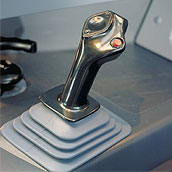|
Contrary to company and check airman advice, I purchased software and training guides from outside sources and proceeded to devour their information. There were two glitches to this method. The first was the manuals and software they provide assume you’ve already been through initial training and thus exposed to the systems. The second was the fact they are based on a different airlines Airbus fleet. Our fleet has a multitude of differences in comparison, and more importantly our procedures are unique to our operation. Therefore, I would not recommend outside materials at this stage in your game. An excellent training aid I discovered and use is the A320 Visual Oral Switch/Light Guide produced by Red Triangle Productions. They have tailored their software to adhere to our company specific Airbus systems and procedures by taking the information directly from our manuals and handbooks. This software not only was a valuable aid to initial training and subsequent oral, but will also provide a complete source of review for CQ training. Every switch, light, and display is documented in detail. In-depth descriptions, limitations, and procedures are provided, as well as supporting system schematics and ECAM presentations. Click on their link above, and you'll have it downloaded onto your computer in less than 10 minutes. I highly recommend you get a copy of this fantastic program. Literally hundreds of our Bus drivers use it, and they all agree. The Bus has more computers than a Dell Computer warehouse, each with it’s own acronym. Matter of fact, the Bus is built on acronyms (Click Here if you don't believe me). This is where my studies previous to beginning training paid off. At least I had been exposed to the majority of these nuances, which made my understanding of the big picture much more coherent.
You’ve got to have the callouts from OM I down cold BEFORE you show up for your first simulator session. You’ll practice these in the FTD during initial ground school, but read and heed! You can download them from the Study Aids section of this site. I would also suggest you spend a few of your off hours using the MCDU trainers in the computer lab. On the 80, a re-route was no big deal. This was a whole new philosophy for me. It’s really slick - once you get the hang of it, and the only way is to practice prior to beginning your simulator training phase. There is a wealth of information to cover in each simulator session. Don’t be surprised if your simulator instructor asks you to show up an hour earlier each day. It’s well worth it in the long run. These guys are really dedicated to getting you through, but you have to come prepared by reviewing the syllabus and procedures the night before each new session. Click here for Airbus Pre-School Material Good luck with school. Once you’re on the airplane, I think you’ll really be glad you bid it.
|
 The general consensus is they will teach
you everything you need to know once you begin initial ground school. The Airbus
is a completely different concept in flying compared to what you've flown in the
past. In addition to the normal systems, the extensive use of
onboard computers coupled with a completely new concept in flight management,
creates a learning curve that is much steeper than what we've experienced in
previous aircraft types. There is an enormous amount of information to learn,
and it would behoove you to start studying now.
The general consensus is they will teach
you everything you need to know once you begin initial ground school. The Airbus
is a completely different concept in flying compared to what you've flown in the
past. In addition to the normal systems, the extensive use of
onboard computers coupled with a completely new concept in flight management,
creates a learning curve that is much steeper than what we've experienced in
previous aircraft types. There is an enormous amount of information to learn,
and it would behoove you to start studying now.
